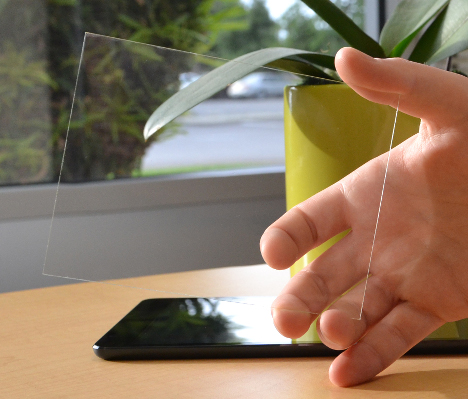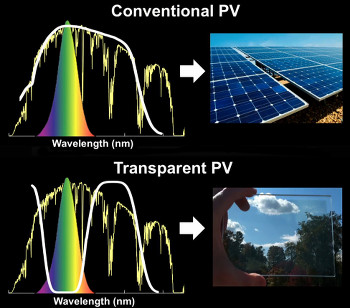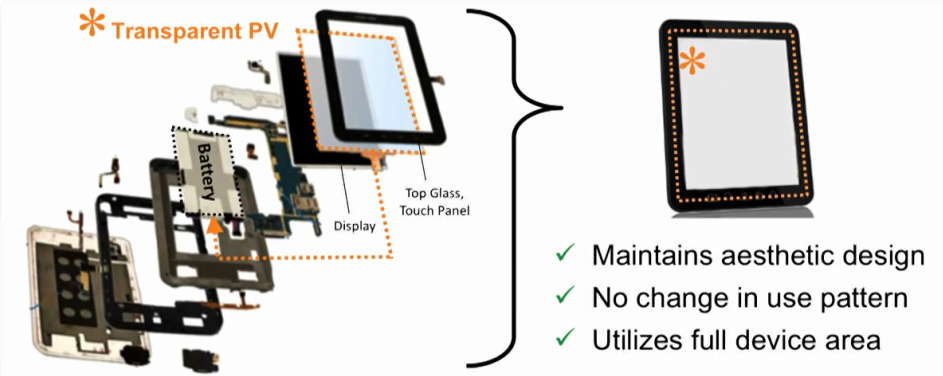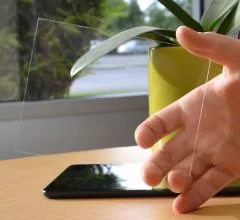Next week at the SID iZone, the display community will have a chance to look at a new technology, being developed just up the road from the event in Redwood City, California by Ubiquitous Energy, a start up that is looking to solve one of the problems of mobile devices – battery life.

 Ubiquitous Energy’s ClearView Power film is transparentUbiquitous has developed a new solar coated film technology that is transparent – it is claimed to be completely transparent at visible frequencies, so causes no degradation of device function. It calls the technology “ClearView Power”. The approach was developed to convert just uv and infrared light to electricity. This has applications in areas such as adding solar panels to windows, but could also be used to put solar panels onto the displays of mobile devices.
Ubiquitous Energy’s ClearView Power film is transparentUbiquitous has developed a new solar coated film technology that is transparent – it is claimed to be completely transparent at visible frequencies, so causes no degradation of device function. It calls the technology “ClearView Power”. The approach was developed to convert just uv and infrared light to electricity. This has applications in areas such as adding solar panels to windows, but could also be used to put solar panels onto the displays of mobile devices.
Traditional solar cells have an efficiency of up to around 33% and Ubiquitous says that it should be able to get to 22%, although devices from its pilot production facility in Redwood City are expected to be able to get to around 10% efficiency. There has been a lot of interest in transparent solar panels, but these are usually made by either making the cell very thin or by covering only part of the surface. Making the panel thinner usually means a colour tint, and that, of course, is not acceptable on a display.
 The core technology was developed at the Michigan State University by assistant Prof. Richard Lunt of the University and his team and is based on the development of small organic molecules that absorb UV and Near Infrared light and convert it to a single infrared wavelength. In one application, the light is guided to the edge of the panel, where it is converted to electricity by photovoltaic cells. In other applications, the material is used in the same way as a traditional opaque photovoltaic panel.
The core technology was developed at the Michigan State University by assistant Prof. Richard Lunt of the University and his team and is based on the development of small organic molecules that absorb UV and Near Infrared light and convert it to a single infrared wavelength. In one application, the light is guided to the edge of the panel, where it is converted to electricity by photovoltaic cells. In other applications, the material is used in the same way as a traditional opaque photovoltaic panel.
We had a chance to talk to Hugo Steemers, a display industry veteran and CEO Miles Barr about the technology in advance of the show. They told us that the first applications will be in applications where the technology can make the biggest difference. For example, eBooks would effectively never need charging with only limited time spent in the light.
Another early application is likely to be electronic shelf labels (ESLs), where the devices could be made without batteries at all, allowing longer lifetime, reduced maintenance and easier disposal at the end of life.
Later, applications such as smartwatches are real prospects, with even a short exposure to sunlight enabling significant time extensions between charges and with low power devices even enabling “infinite” battery life.
Ubiquitous sees the technology as being suitable for mobile applications as it can be mounted between a procap touch panel and the display.

The company looks to have a strong team, has raised over $8 million and has already been the recipient of awards including National Science Foundation Small Business Innovation Research and Small Business Technology Transfer grants, a Fraunhofer-Techbridge U-Launch Award, a MassCEC MTTC Catalyst Award, and the MIT Clean Energy Prize Renewables Category.
Analyst Comment
As Bob O’Donnell wrote in his recent Display Daily (Wearable Power Limits Pose Display Challenges) that finding ways to harvest energy to charge mobile devices was going to be a critical technology going forward. Ubiquitous seems right in this area and I’m really looking forward to seeing what the company can do next week. (BR)

